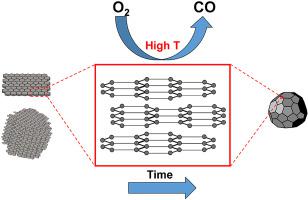Our official English website, www.x-mol.net, welcomes your
feedback! (Note: you will need to create a separate account there.)
O2-Oxidation of Individual Graphite and Graphene Nanoparticles in the 1200 – 2200 K Range: Particle-to-Particle Variations and the Evolution of the Reaction Rates and Optical Properties
Carbon ( IF 10.5 ) Pub Date : 2021-03-01 , DOI: 10.1016/j.carbon.2020.10.053 Daniel J. Rodriguez , Chris Y. Lau , Bryan A. Long , Susanna An Tang , Abigail M. Friese , Scott L. Anderson
Carbon ( IF 10.5 ) Pub Date : 2021-03-01 , DOI: 10.1016/j.carbon.2020.10.053 Daniel J. Rodriguez , Chris Y. Lau , Bryan A. Long , Susanna An Tang , Abigail M. Friese , Scott L. Anderson

|
The kinetics for O2 oxidation of individual graphite and graphene platelet nanoparticles (NPs) were studied as a function of temperature (1200 to 2200 K) at varying oxygen partial pressures, using a single nanoparticle mass spectrometry method. NP temperature (TNP) was measured by measuring the NP thermal emission spectra during the kinetics studies. The initial oxidation efficiency is found to peak in the 1200 to 1500 K range, dropping by an order of magnitude as TNP was increased above 2000 K. There were large NP-to-NP variations in the oxidation rates, attributed to variations in the NP surface structure. In addition, the oxidation efficiencies decreased, non-monotonically, as the NPs reacted, by factors of between 10 and 300. This evolution of reactivity is attributed to changes in the NP surface structure due to the combination of oxidation and annealing. The optical properties, including wavelength dependence of the emissivity, and the absorption cross section for the 532 nm heating laser, also tend to evolve as the NPs oxidize, but differently for each individual NP, presumably reflecting differences in the initial structures, and how they evolve under different reaction conditions.
中文翻译:

1200 – 2200 K 范围内单个石墨和石墨烯纳米颗粒的 O2 氧化:颗粒间变化以及反应速率和光学特性的演变
使用单一纳米粒子质谱法,在不同的氧分压下,研究了作为温度(1200 至 2200 K)的函数的单个石墨和石墨烯片状纳米粒子 (NPs) 的 O2 氧化动力学。通过在动力学研究期间测量 NP 热发射光谱来测量 NP 温度 (TNP)。发现初始氧化效率在 1200 到 1500 K 范围内达到峰值,随着 TNP 增加到 2000 K 以上,氧化效率下降了一个数量级。 由于 NP 的变化,氧化速率存在很大的 NP 到 NP 变化表面结构。此外,当 NP 反应时,氧化效率非单调地降低了 10 到 300 倍。这种反应性的演变归因于氧化和退火的结合导致 NP 表面结构的变化。光学特性,包括发射率的波长依赖性和 532 nm 加热激光的吸收截面,也倾向于随着 NPs 氧化而演变,但每个单独的 NP 不同,大概反映了初始结构的差异,以及它们如何在不同的反应条件下演化。
更新日期:2021-03-01
中文翻译:

1200 – 2200 K 范围内单个石墨和石墨烯纳米颗粒的 O2 氧化:颗粒间变化以及反应速率和光学特性的演变
使用单一纳米粒子质谱法,在不同的氧分压下,研究了作为温度(1200 至 2200 K)的函数的单个石墨和石墨烯片状纳米粒子 (NPs) 的 O2 氧化动力学。通过在动力学研究期间测量 NP 热发射光谱来测量 NP 温度 (TNP)。发现初始氧化效率在 1200 到 1500 K 范围内达到峰值,随着 TNP 增加到 2000 K 以上,氧化效率下降了一个数量级。 由于 NP 的变化,氧化速率存在很大的 NP 到 NP 变化表面结构。此外,当 NP 反应时,氧化效率非单调地降低了 10 到 300 倍。这种反应性的演变归因于氧化和退火的结合导致 NP 表面结构的变化。光学特性,包括发射率的波长依赖性和 532 nm 加热激光的吸收截面,也倾向于随着 NPs 氧化而演变,但每个单独的 NP 不同,大概反映了初始结构的差异,以及它们如何在不同的反应条件下演化。









































 京公网安备 11010802027423号
京公网安备 11010802027423号